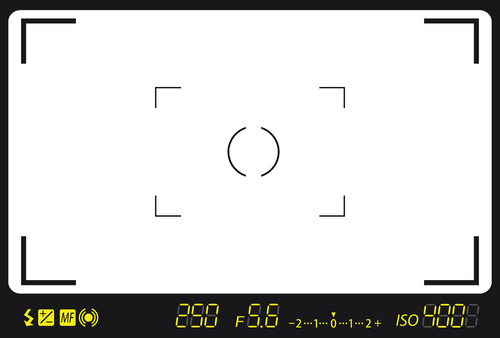Using Your Camera’s Auto Focus
Shooting an action photo with sharp focus is really the ultimate goal in sports photography. Sure, there may be times when photographers try to show motion, and will intentionally let the action blur, but 98% of the time, you want to capture the emotion and incredible contortions an athlete goes through during the course of a game. Plus, you want to be able to tell that this is your son, daughter, spouse, or friend in the photo. Capturing the subject with crystal clarity is the way to get that done.
Focus is achieved in two ways: using a fast enough shutter speed to freeze the action, or using your auto focus. This second option (auto focus) is what we will (ahem) focus on in this article.
Today’s cameras have amazing auto focus capabilities. We can set our camera to auto focus and let the camera do all the work. Some of the more expensive longer lenses even have ultra-sonic motors built in to help with the tracking of the moving subject. But, camera technology is only powerful if you know how to use it correctly. Auto focus has become something that most camera owners take for granted these days. However, there are a few camera settings that control how that auto focus works, and these are often overlooked. Here are three auto focus areas that every photographer needs to be aware of.
1. Auto Focus Modes
It seems as if you should be able to just attach a lens with auto focus capabilities, click the shutter, and the lens should snap into focus and take the photo. However, camera manufactures are always on the hunt for how to customize your settings. Sometimes it makes your life easier and sometimes it makes you have to work a bit harder to get the shot. In the realm of auto focusing, there are a few optional modes that are available to you. Let’s look at the two most important ones:
Single Shot Focusing (One Shot for Canon or AF-S for Nikon): This is the auto focus mode for subjects that are not moving. Push the shutter button halfway, let the camera find the subject and locks down the focus, then push the shutter the rest of the way to take the photo. This setting is perfect for still life, but not for sports.
Continuous Focusing (Canon calls it AI Servo and Nikon calls it AF-C): This is the mode you have to be on when shooting sports. In this mode, once you push the shutter button halfway, the auto focus will track the moving subject until you push the button all the way down. It takes some practice, but it is a necessity for all action shooters.
There is another mode called AI Focus, which is an attempt by camera manufacturers to make a hybrid of the two modes. If the subject is moving, it keeps on tracking, but if it stops, it will lock. This setting is interesting, but for sports photography, don't mess with it. Stay in the continuous focus mode.
2. Focus Points
Another thing to be aware of on your camera is the focus points. Again, this is the camera maker getting fancy and allowing customization. Here is how it works: when you push your shutter button halfway to activate your auto focus, the focus point is the part of the photo that will snap into focus. It is basically like the cross hairs of a scope. If you set your focus point in the center, that is the spot that your camera will focus on. You can also move that around and make the hot spot at the bottom, top, or side. You can even increase the area of your focus point or make it smaller.
Many photographers prefer to keep the focus point in the center of the viewfinder. The camera and lens will put that spot in focus. To illustrate this point, think about this a common scenario: you are photographing soccer and there is an athlete with the ball and a defender trying to take it away. You have two people in your frame, one on the right and one on the left. Once you push your shutter halfway to focus, your auto focus springs to life and follows your command to put that center spot in focus. The problem is that center spot is now hitting a mom in the background under the bright blue umbrella. So when you view the photos later you see two out of focus athletes and a perfectly focused image of a fan in the background. Has that happened to you? Once that focus spot is chosen, you need to be aware that this is the spot the lens will focus on each time.
3. Back Button Focusing
Talk about a top secret sports photographer weapon! This is one of those customization tools that will dramatically improve your photography skills. While this is more on the advanced side, if you play with this and get good at it, you will never go back.
The auto focus functionality relies on a two-step process. Push your shutter button halfway, which engages the auto focus, and then snap the photo by pushing the button completely. The problem with that is the lag time and the instability of pushing the button halfway. For instance, let's say a fantastic moment happens on the field very quickly. If you want to capture that moment you would push the trigger. Now your camera has to find the focus, then trip the shutter. In the sports world, that is an eternity. You need to catch it immediately.
There is a setting in your camera (do some research in your camera manual or online to personalize for your own camera) called Back Button Focus, which allows you to control your focus with your thumb on the back of your camera by pushing a designated button. Now you can follow the action through your camera and use your thumb to lock in the focus as the play progresses. When you see a moment you want to capture, simply push the shutter button and the shot is instantaneous. There is no lag time because you have already been tracking the focus, and your hands are steadier, which helps get a clearer shot. You are moving the auto focus command from the shutter button to a button on the back of your camera, giving you much more control.
To review, get your camera out of that One Shot mode and over to the Continuous Focus mode. Be aware of where your focus point is, and practice. Ready to step up to a new level? Try the Back Button Focus mode.
As always, have a blast!
NEW! Free Sports Organization Resources
All of TeamSnap's ebooks, articles, and stories in one place. Access Now



